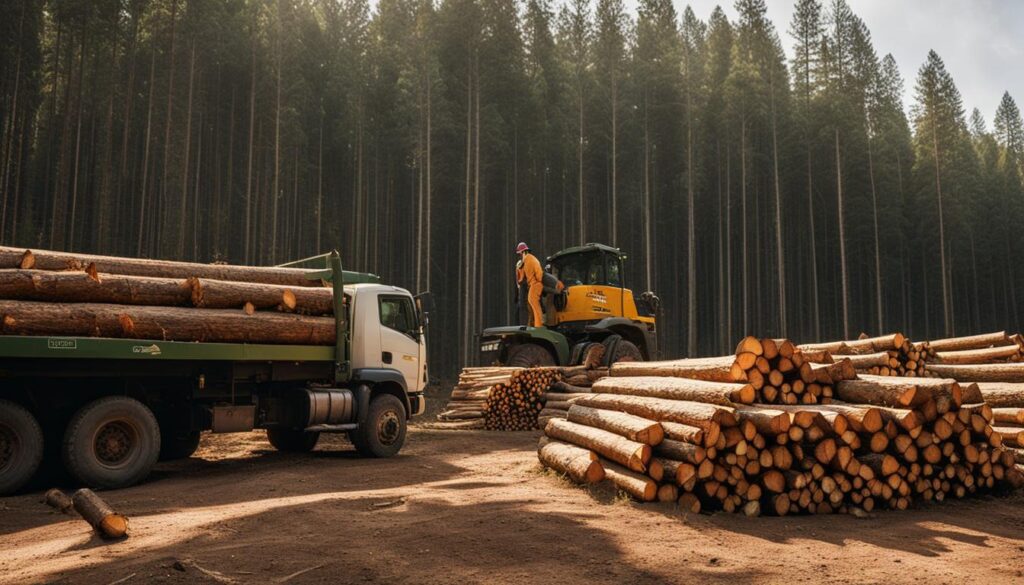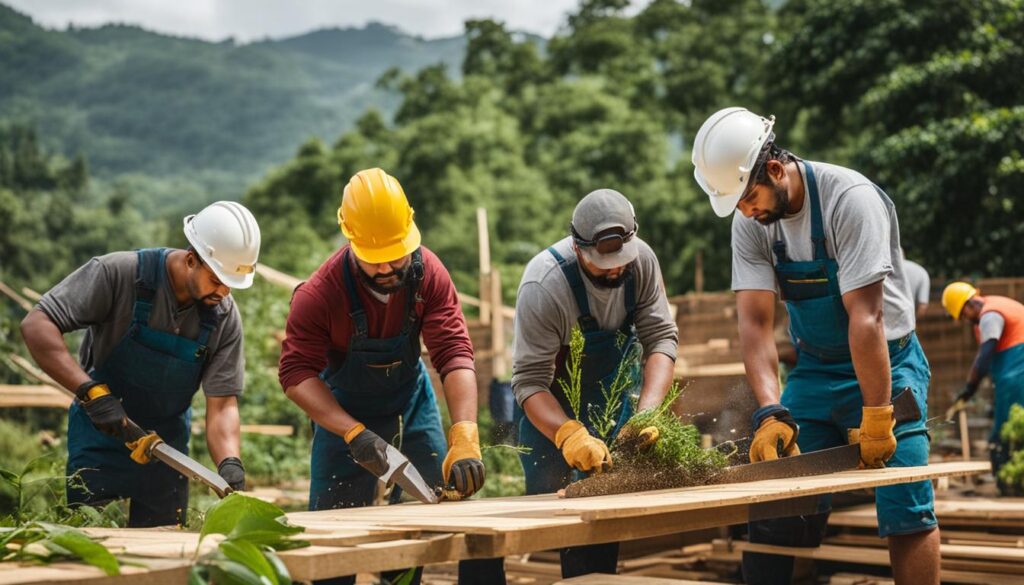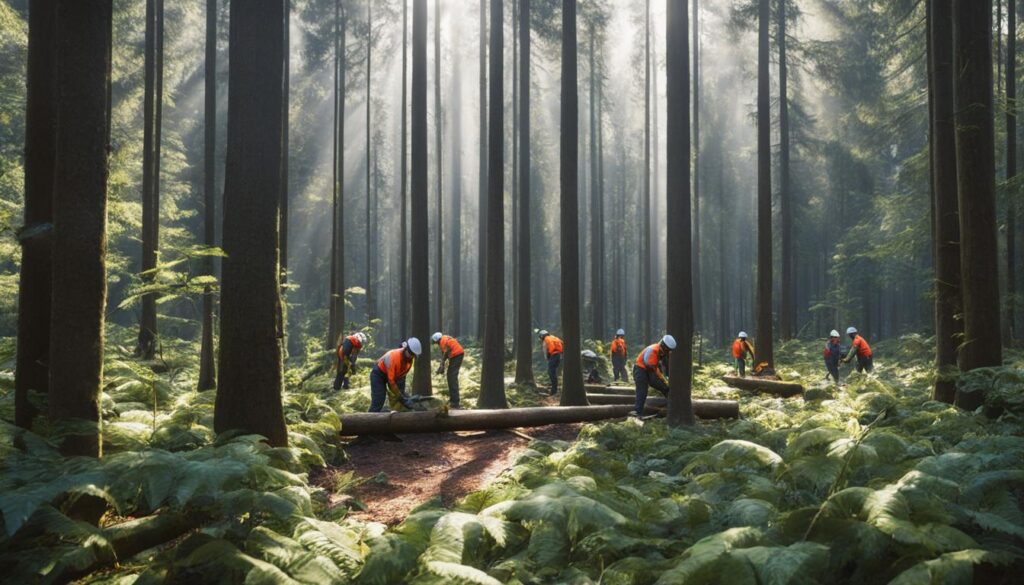Welcome to our comprehensive guide on using locally sourced timber for sustainable construction in Victoria. In recent years, eco-friendly building practices have gained significant traction, and timber has emerged as a key component for sustainable construction. Our guide aims to provide readers with relevant, reliable, and up-to-date information on the benefits of locally sourced timber and how it can be utilized in construction projects in Victoria.
As the demand for sustainable construction grows, it has become increasingly crucial to utilize materials that are environmentally friendly, cost-effective, and readily available. Timber from local forests in Victoria provides an excellent solution, as it is a renewable and biodegradable material with a low carbon footprint and supports the local economy.
In this article, we explore the many benefits of locally sourced timber for sustainable construction in Victoria. We provide guidance on selecting sustainable timber sources, understanding the importance of sustainable timber certification, and finding local timber suppliers. We also highlight successful sustainable timber projects in Victoria and showcase modern eco-friendly building practices that utilize timber effectively.
Key Takeaways
- Locally sourced timber is an environmentally friendly and cost-effective material for sustainable construction in Victoria.
- Sustainable timber certification is crucial for ensuring the traceability and sustainability of timber products.
- Supporting local timber suppliers creates a positive impact on the local economy and helps reduce transportation emissions.
- Choosing the right type of timber for construction projects involves considering factors such as durability, strength, and environmental impact.
- Sustainable construction techniques such as modular construction, timber frame systems, and efficient insulation promote eco-friendly building practices.
Importance of Locally Sourced Timber
When it comes to sustainable construction practices, locally sourced timber plays a crucial role in reducing the carbon footprint of a project. By sourcing timber from Victoria, we minimize transportation emissions and support the timber industry in Victoria.
Not only does using locally sourced timber benefit the environment, but it also supports the local economy. The timber industry in Victoria is a significant contributor to the state’s economy, providing employment opportunities and generating revenue.
Furthermore, by sourcing timber locally, we can ensure that it is sustainably harvested and has a lower environmental impact. This reduces our reliance on timber sourcing from other countries, which may have less strict regulations and environmental standards.
Overall, using locally sourced timber is a win-win situation for both the construction industry and the environment. In the next section, we will explore the concept of sustainable building materials, including the various types of timber that can be used for eco-friendly construction projects.
Sustainable Building Materials
At our company, we believe in promoting eco-friendly construction practices, and using sustainable building materials is a crucial part of that. One of the most popular sustainable materials for construction is timber, which can be used in a variety of ways to create beautiful, durable, and sustainable buildings.
Timber is an incredibly versatile material that can be sourced sustainably. Using sustainable timber sources for construction helps protect the environment while creating stunning structures. In Victoria, timber can be sourced locally, reducing transportation emissions and supporting the local timber industry in Victoria.

There are many different types of sustainable timber sources that can be used in construction. Some of these include:
| Type of Sustainable Timber | Description |
|---|---|
| Reclaimed Timber | Recycled from old buildings instead of being discarded, reducing the need to fell more trees |
| Certified Timber | Timber that has been certified as sustainable by organizations like the Forest Stewardship Council (FSC) or the Australian Forestry Standard (AFS) |
| Eco-Friendly Timber | Timber grown and harvested in a way that minimises harm to the environment |
Using these sustainable building materials not only helps protect the environment, but also often contributes to a more beautiful and unique finished product. The natural look and feel of timber provides an earthy, calming aesthetic that can be hard to achieve with other building materials.
In the next section, we’ll explore the concept of sustainable timber certification to ensure our readers fully understand the importance of utilizing sustainable timber sources.
Understanding Sustainable Timber Certification
In Victoria, the timber industry is a crucial contributor to the local economy. However, it is important to ensure that this resource is utilized sustainably. Sustainable timber certification is an essential tool in achieving this goal.
Certifications such as Forest Stewardship Council (FSC) and Australian Forestry Standard (AFS) provide assurance that the timber comes from responsibly managed forests. The FSC certification is recognized globally and promotes environmentally appropriate, socially beneficial, and economically viable forest management. Similarly, the AFS certification guarantees that timber products originate from forests certified under the Australian Standard for Sustainable Forest Management.
These certifications are vital in ensuring that the timber industry in Victoria is sustainable and allows for future generations to continue to benefit from this valuable resource.
“The continued growth of the Australian forest industry relies on the sector’s sustainability, integrity, and ability to adapt. Certification schemes like FSC and AFS play a critical role in ensuring these factors are met.” – Ross Hampton, CEO of the Australian Forest Products Association.
By choosing sustainably certified timber, consumers can support the local industry while maintaining a commitment to environmental and social responsibility. It also ensures that the timber’s origin is traceable, making it easier to confirm sustainability and legality in compliance with local laws and regulations.
Locating Local Timber Suppliers
At Victoria, we believe in supporting local businesses and reducing transportation emissions. That’s why it’s important to know where to find local timber suppliers for your construction projects.
One way to find local timber suppliers is through industry associations such as the Timber Trade Industrial Association (TTIA) or by contacting the Victorian Association of Forest Industries (VAFI). These organizations can provide a list of qualified and reputable timber suppliers in Victoria.
You can also search online directories like the Green Pages or the Australian Timber Database for local timber suppliers. These directories will give you a comprehensive list of timber suppliers with their contact information, location and product details.
Finally, word-of-mouth referrals from colleagues in the construction industry can be valuable in finding reliable local timber suppliers. Don’t hesitate to ask for recommendations from other builders or architects who have used local timber in their projects.

It’s important to note that when sourcing timber, it’s crucial to consider sustainability and verify if the supplier has any certification from organizations such as the Forest Stewardship Council (FSC) or Australian Forestry Standard (AFS). These certifications ensure that the timber comes from sustainably managed forests, which helps to minimize the environmental impact of construction projects.
By sourcing locally and sustainably, you can support the local timber industry in Victoria and invest in the long-term sustainability of our environment.
Factors to Consider When Selecting Timber
Choosing the right timber is crucial for sustainable construction. Several factors should be considered when sourcing timber, including:
- Durability: The durability of timber ensures that it lasts for an extended period. It’s essential to know the lifespan of different timbers to determine which one is suitable for your construction project.
- Strength: The strength of timber is essential in determining its suitability for construction projects. It should be able to hold up the weight of the intended structure or application and withstand weather elements such as wind and rain.
- Environmental impact: It’s critical to consider the environmental impact of the timber being sourced. Ensure that the timber comes from sustainable timber sources and has forest certification, such as Forest Stewardship Council (FSC), to guarantee your timber comes from responsibly managed forests.
When selecting timber, ensure that it meets Australian standards for quality and structural stability. Consider the grading, moisture content and treatment requirements, depending on the intended application.
Comparative Analysis of Sustainable Timber Sources
| Timber Type | Benefits | Challenges |
|---|---|---|
| Blackbutt | Durable, termite resistance, suitable for exposed structures, fire resistance | Not suitable for in-ground use, drying out can cause warping |
| Ironbark | Highly durable, termite and rot-resistant, suitable for heavy construction | Challenging to work with, high in embodied energy |
| Spotted Gum | Durable, termite and rot-resistant, attractive appearance | Flammable and requires treatment for fire safety, expensive |
| Tallowwood | Durable, low maintenance, weather-resistant, suitable for outdoor use, fire-resistance | Expensive, limited supply |
Choosing timber isn’t a straightforward task. It’s essential to prioritize sustainable timber sources and consider the several factors that align with your construction needs to achieve your design objectives while ensuring environmental compliance and sustainability.
Sustainable Timber Construction Techniques
When it comes to sustainable construction, using timber can be an excellent choice. By employing the right construction techniques, the results can be even more eco-friendly. Let’s take a look at some of the strategies that can be used to promote sustainable construction with timber:
Modular construction
Modular construction involves building prefabricated sections off-site and then assembling them on-site. This approach can significantly reduce construction time and costs while minimizing waste and emissions. Moreover, because modular construction is so customizable, it’s possible to create unique, eco-friendly designs that are tailored to the needs of individual projects.
Timber frame systems
Timber frame systems are becoming increasingly popular for sustainable construction. These systems use timber posts and beams to support the structural load of a building, rather than traditional masonry or concrete. Not only does this approach reduce the carbon footprint of construction, but it can also create beautiful, open-plan spaces with natural lighting and ventilation.
Efficient insulation
Efficient insulation is an essential element of sustainable construction. It can help to reduce energy consumption and cut down on greenhouse gas emissions. By using timber in construction projects, it’s possible to take advantage of its natural insulating properties. Additionally, by pairing timber with other eco-friendly insulation materials, such as sheep’s wool or cellulose, even greater energy efficiency can be achieved.

“By employing these sustainable timber construction techniques, we can create buildings that are not only beautiful and functional but also environmentally responsible and sustainable.”
Case Studies: Successful Sustainable Timber Projects in Victoria
In Victoria, sustainable construction practices have resulted in several successful projects that highlight the potential of using locally sourced timber.
One of these projects is the Library at The Dock in Melbourne. This community hub, constructed entirely from sustainable materials, including CLT (Cross-Laminated Timber), has won numerous awards for sustainability. The timber sourced for this structure was grown within a 150km radius of Melbourne, demonstrating the benefits of utilizing locally sourced materials.
Another project that has caught our attention is the Woor-Dungin Youth Justice Service Centre in Malmsbury. The sustainable building practices used in the construction of this facility include passive solar design, rainwater harvesting, and the use of locally sourced, Forest Stewardship Council (FSC) certified timber. These practices highlight the potential of combining eco-friendly design elements with the use of sustainably sourced timber to create environmentally responsible buildings.
The Windermere Children’s Services Centre in Ballarat is yet another example of a successful sustainable timber project. This multi-purpose center has achieved a 5-Star Green Star rating and has been constructed entirely from sustainably sourced local timber. The use of timber has created a warm and inviting atmosphere, contributing to the center’s overarching goal of creating a nurturing environment for children and their families.
Overall, these case studies demonstrate the potential of using locally sourced timber in sustainable construction projects in Victoria. By choosing eco-friendly building practices and sustainably sourced materials, we can create buildings that are not only environmentally responsible but also beautiful and inviting.
Conclusion
As we conclude our guide to locally sourced timber for sustainable construction in Victoria, we hope to have inspired you to embrace eco-friendly building practices.
The benefits of sustainable construction are numerous, ranging from positive impacts on the environment to supporting the local timber industry. By opting for sustainable building materials and employing techniques such as modular construction and efficient insulation, we can reduce our environmental footprint while enhancing the quality and comfort of our buildings.
Our guide has provided an overview of the significance of locally sourced timber, sustainable timber certification, and factors to consider when choosing timber for construction projects. We have also showcased successful sustainable timber projects in Victoria, demonstrating the potential of this environmentally friendly material.
We encourage you to use this guide as a resource for your future sustainable construction projects. By working together to promote sustainable practices, we can create a better future for ourselves and for the environment.
Thank you for joining us on this journey towards sustainable construction in Victoria.
Keywords: A Guide to Locally Sourced Timber for Sustainable Construction in Victoria, sustainable construction.
FAQ
What are the benefits of using locally sourced timber for construction?
Using locally sourced timber for construction projects in Victoria has several benefits. Firstly, it helps reduce transportation emissions since the timber doesn’t have to travel long distances. Additionally, it supports the local timber industry, which contributes to the economic growth of the region.
Are there sustainable timber sources in Victoria?
Yes, Victoria has sustainable timber sources that can be utilized for construction. These include timber from well-managed plantations, reclaimed timber, and timber from certified forests that adhere to sustainable forestry practices.
What is the importance of sustainable timber certification?
Sustainable timber certification, such as the Forest Stewardship Council (FSC) and Australian Forestry Standard (AFS), ensures that the timber used in construction projects is sourced from responsibly managed forests. They provide assurance of the timber’s sustainability, traceability, and adherence to environmental and social standards.
How can I find local timber suppliers in Victoria?
When looking for local timber suppliers in Victoria, you can start by searching online directories or contacting industry associations. It’s also helpful to connect with local builders and contractors who can recommend reliable and sustainable timber suppliers in the region.
What factors should I consider when selecting timber for construction?
When choosing timber for construction projects, it’s important to consider factors such as durability, strength, and environmental impact. Look for timber species that are known for their strength and resistance to decay. Additionally, consider the timber’s sourcing and whether it aligns with sustainable forestry practices.
What are some sustainable timber construction techniques?
There are several sustainable timber construction techniques that can be employed. These include modular construction, which reduces waste and allows for efficient assembly on-site. Timber frame systems provide structural integrity and energy efficiency. Additionally, using efficient insulation materials and techniques can enhance the building’s energy performance.
Can you provide examples of successful sustainable timber projects in Victoria?
Certainly! Some successful sustainable timber projects in Victoria include the Melbourne Docklands Library, which utilized sustainably sourced timber throughout its construction. Another example is the Victorian College of the Arts in Southbank, which incorporated timber throughout its design to create a sustainable and aesthetically pleasing campus.
Why is sustainable construction important in Victoria?
Sustainable construction is essential in Victoria to reduce environmental impacts, promote resource efficiency, and support the local timber industry. By utilizing locally sourced timber and adopting eco-friendly building practices, we can ensure a more sustainable and resilient built environment for future generations.
